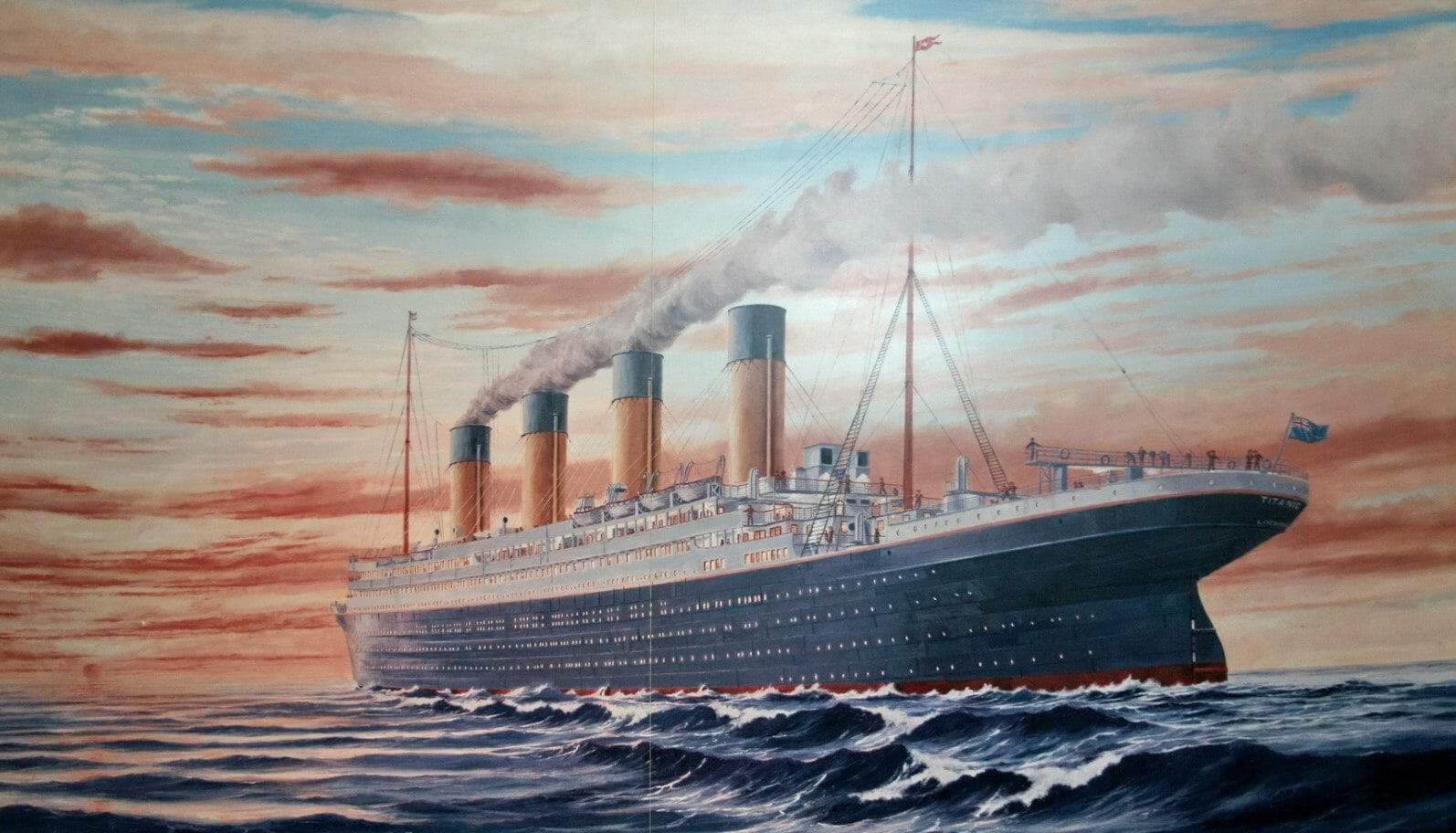│by Chloe Villalon, Gale Ambassador at the National University of Ireland Galway│
Often students such as myself have a broad idea of the topic they’re interested in, but they’re not sure which angle to take. In these cases it might be helpful to talk to a friend, professor or peer who may provide interesting insight or suggestions. Gale Primary Sources is also a great platform to find both ideas and articles – you can turn to it when you’re still looking for a topic or when you have a defined notion of what you’re looking for and want to dig deeper. In this blog post I will show you how you can use different tools to go from having a vague topic, to developing an angle, to writing a narrative or argument.
Last week, I was talking to a friend about writing a blog post on the Titanic. The RMS Titanic sank on April 15, 1912 – exactly 108 years ago today! At first, I thought I might look at how the news was shared, but I did not have a precise idea of where I wanted my article to go. My friend suggested I look into Bruce Ismay. Bruce Ismay was the Managing Director of the White Star Line and he was aboard the Titanic on its maiden voyage. He survived the shipwreck but, although he was cleared of all blame, he never recovered from the tragedy. He kept a low profile and lived part of the year in Costelloe Lodge, a cottage in Casla, Connemara, in the Republic of Ireland, which is less than an hour away from my house. A curious fact is that Bruce Ismay sounds like “Brú síos mé” which is Gaelic for “push me down”.
Efficient research techniques
To begin with, I want to show you the steps I take on the Gale Primary Sources platform to most efficiently research a topic. Firstly, when using the regular search bar, I make sure to add quotation marks around the words I’m searching i.e. “Bruce Ismay”. This ensures that the search engine will look for the words Bruce and Ismay consecutively. Without the quotation marks, you might find articles that contain both Bruce and Ismay, but which do not refer to Bruce Ismay.
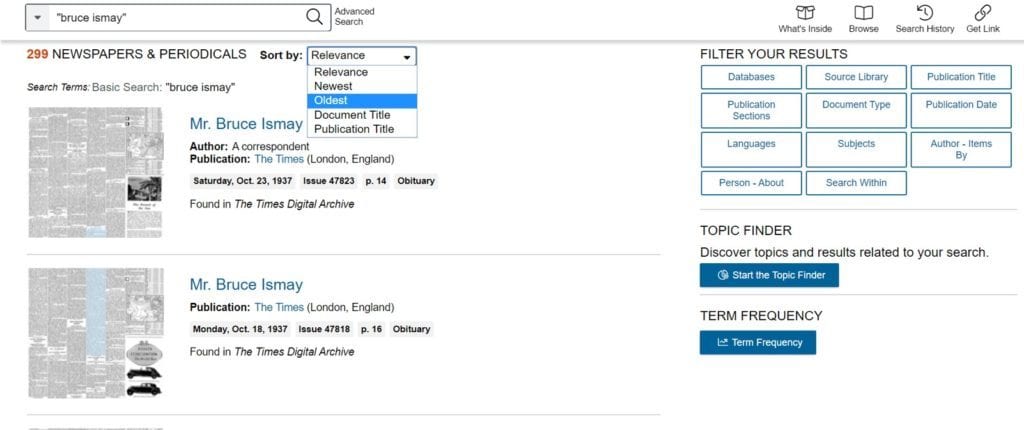
From the first search results page, I selected the “Newspapers & Periodicals” option. I can then choose to sort the results by Relevance, Newest, Oldest, Document Title or Publication Title. There are 299 results and it would take me a very long time to look at every one of those articles! Research is about being thorough, but also efficient. For that reason, I click on the Term Frequency tool. I want to show you how to use the tool, and useful it can be when researching a topic.
Using the Term Frequency Tool
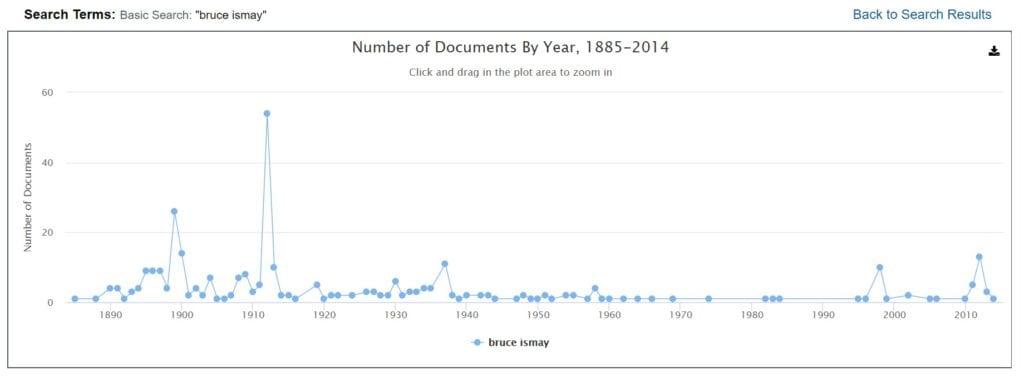
The visualisation produced by the Term Frequency tool gives me a good overview of all the articles that mention Bruce Ismay. Ismay received steady media coverage in the 1890s with a spike in the number of articles mentioning his name in 1899. By clicking on that point in the graph, I am taken to the page of results which contain “Bruce Ismay” and which were were also published or written in 1899. Looking through these articles, it seems the spike in references to Bruce Ismay in this year was due to the launch of the RMS Oceanic on January 16, 1899.
1899: The Launch of the Oceanic and Thomas Ismay’s Death
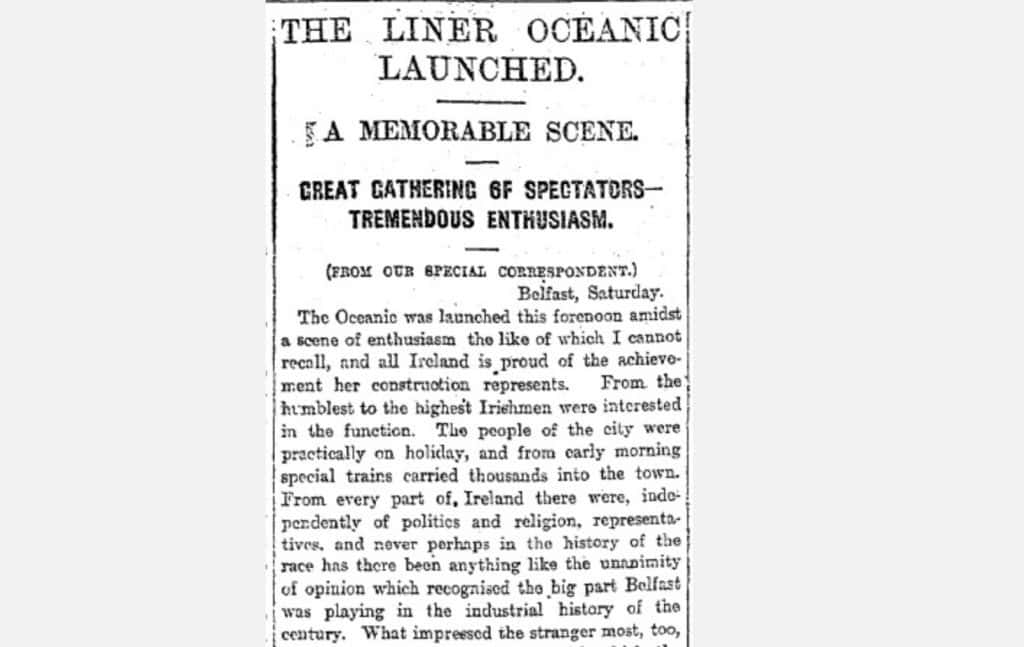
The RMS (Royal Mail Ship) Oceanic was built in Ireland, more specifically in Belfast. According to the article above from the Glasgow Herald, at least 100,000 people were present for the launch and its preparations, including Bruce Ismay. This article is quite lengthy so, after reading the full article, when I wanted to go back to the specific paragraph which mentions the number of attendants, I used the “Search within document” tool, typing “100,000”. This useful trick saved me having to re-read the whole article!
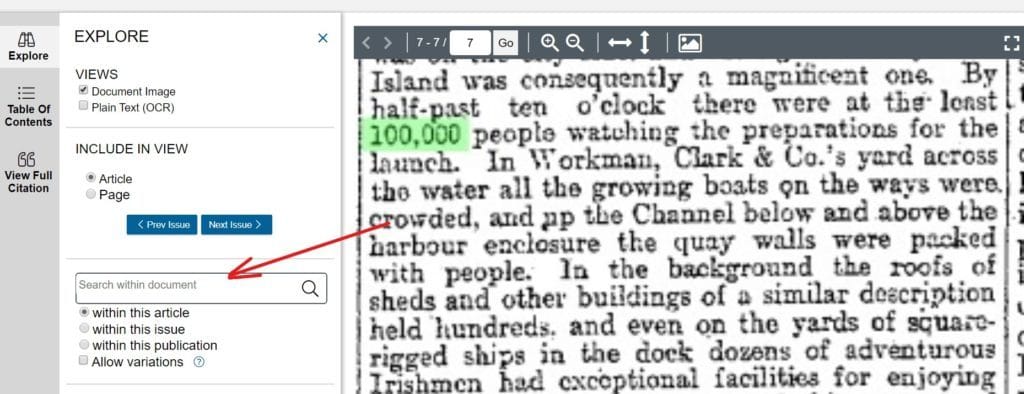
Another reason there were a lot of articles mentioning Bruce Ismay in 1899 is that his father, Thomas Ismay, passed away on November 23 of that year. The fact that the notice for Thomas Ismay’s death is a very lengthy article is telling of the fact that he was a well-known, and apparently well-liked, person.
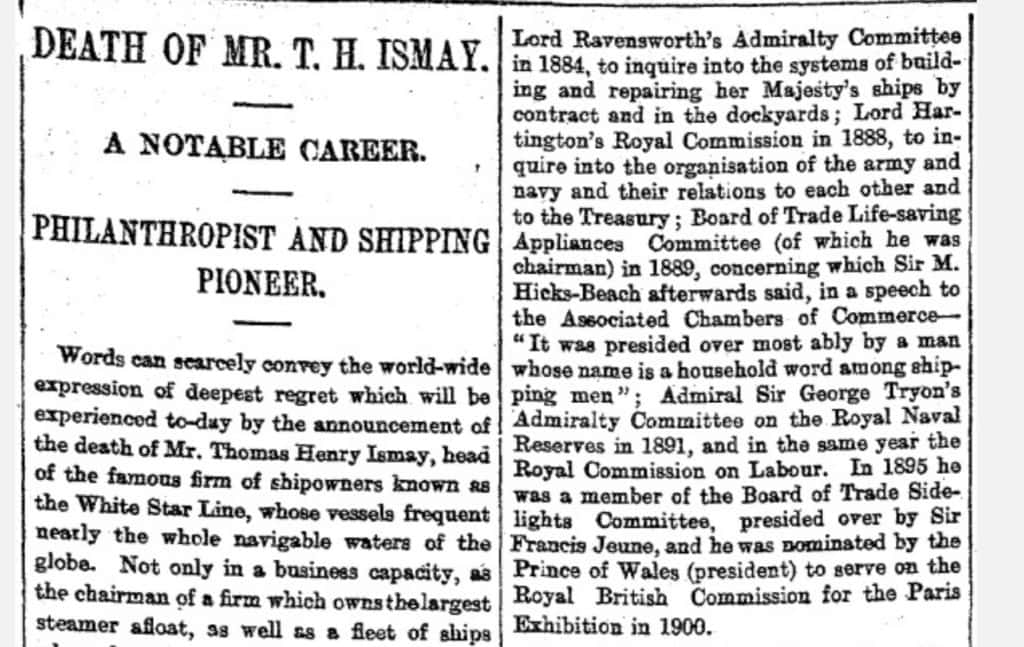
The RMS Titanic sinks in 1912
Unsurprisingly, the year in which the most articles mention Bruce Ismay is 1912, the year during which the Titanic sank. By clicking on that year in the Term Frequency tool, I can then view the Topic Finder tool’s visualisation for results relating to Bruce Ismay from 1912 (see below).
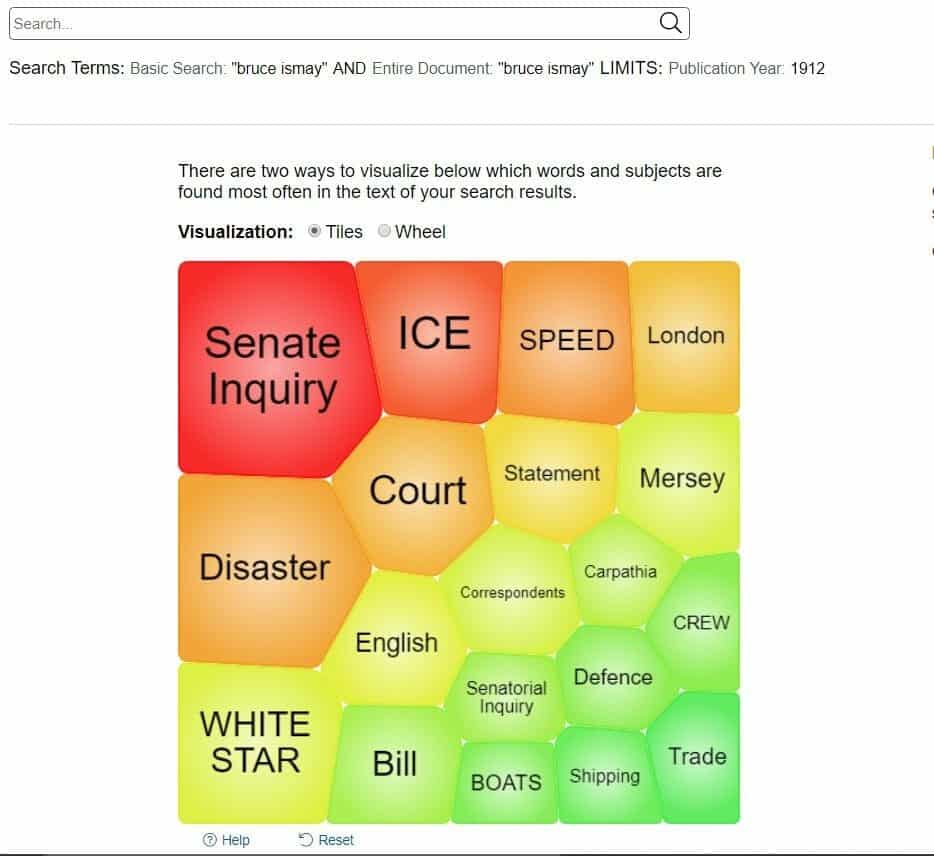
As Chairman of the White Star Line and having survived the shipwreck, Ismay was the subject of a number of attacks on both the lack of lifeboats aboard, and his own escape from the ship. This article from The Times Digital Archive states that, “In a bitter indictment of the officials of the White Star Line, Mr. Raynor designated Mr. Bruce Ismay as the ‘officer primarily responsible for the whole disaster who has reached his destination in safety and unharmed.’ Further on Mr. Raynor said: ‘Mr. Bruce Ismay claims, according to reports, that he took the last lifeboat. I do not believe it, and if he did, it was cowardly to take any lifeboat, for the Managing Director of the line, with his board, is criminally responsible for this appalling tragedy.’”
In the Chicago Journal a few days after the Titanic went down, Ben Hecht contrasted the actions of the captain with that of Bruce Ismay:
“The Captain sank as a man of rank
While his owner turned away
The Captain’s grave was his bridge, and brave
He earned his seaman’s pay.
To hold your place in the ghastly face
of death on the sea at night
is a seaman’s job, but to flee with the mob
is an owner’s noble right.” 1
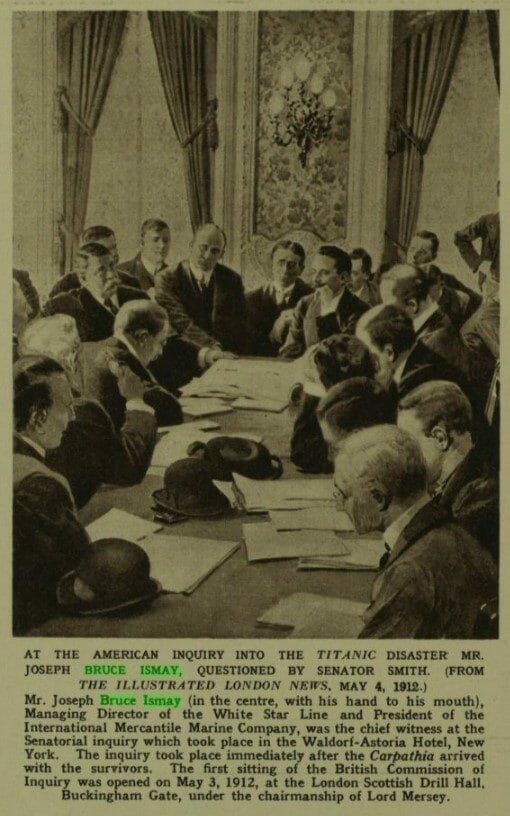
Bruce Ismay’s death in 1937
Ismay was cleared of all blame but he never recovered from the tragedy. He died aged 74 in 1937, another year during which several newspaper articles (7) mention his name, most of them announcing his death or giving an account of the funeral service held for him.
James Cameron’s Titanic
Finally, the fact that ten articles mentioned Ismay’s name in 1998 can be pinned down to the release of James Cameron’s Titanic at the end of 1997. In The Times Literary Supplement, Will Eaves writes about the movie, “Some guilt is pre-emptively assuaged and some blame attached (…) One instance of cowardice is well handled; as he takes his unearned place in the last boat lowered to starboard board, the President of the White Star Line Bruce Ismay (a nervous Jonathan Hyde), shields his face with a shaking hand to avoid his officers silent reproach.” This suggests that more than eighty years after the tragedy, Bruce Ismay is still considered a coward for having escaped the shipwreck.
For contemporary reporting of other disasters, check out “The Peterloo Massacre, August 1819” or “Explaining Volcanic Eruptions from the Late Eighteenth Century to the Modern Day“.
Blog post image citation: RMS Titanic, photo of image taken by Cliff at “Titanic – The Experience”, Convention Centre, Colorado, February 2009. https://www.flickr.com/photos/nostri-imago/3279461836

